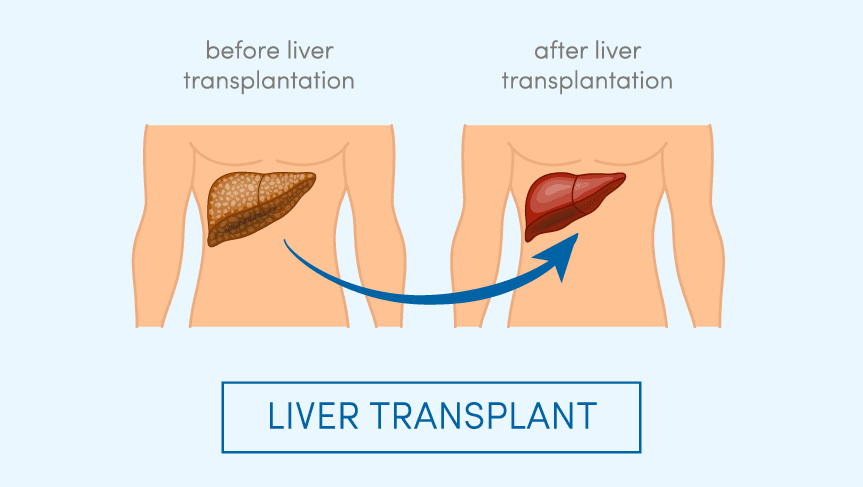Liver transplantation (LT) is indicated for the treatment of acute liver failure (ALF) and end-stage liver disease (ESLD). Currently, the overall 1-year and 5-year post-LT patient survival rates are 80-90% and 60-75%, respectively.
Liver transplantation can be classified according to the type of donor, into deceased and live donor liver transplants.
Liver grafts in the Western countries come predominantly from deceased donors in around 95% of the cases*. Orthotopic liver transplantation (OLT) is by far the most common procedure, where the native liver is removed then replaced by the donor liver in the same anatomic position.
Whilst most liver transplants are of the whole organ, segmental liver transplantation or reduced graft can also be performed.
- Segmental (or split) liver transplantation allows transplanting two recipients (commonly an adult and a child) with a single cadaveric organ
- Reduced grafts accommodates for cases with a mismatch between the size of the donor and the recipient
*Live liver donation, whereby only part of the liver is transplanted from a living donor, constitutes the major source for organ donation in the Far East (e.g. Japan and Korea) and in some other countries where cultural beliefs and customs regarding burial after death limit transplantation from deceased donors of whole organs

due to chronic HCV infection, alcoholic liver disease (ALD), or non-alcoholic fatty liver disease (NAFLD).
Other conditions include:
- Non-cholestatic liver disorders
- Chronic HBV infection, autoimmune hepatitis, or cryptogenic
- Cholestatic liver disorders
- Primary biliary cirrhosis (PBC) or Primary sclerosing cholangitis (PSC)
- Metabolic liver disorders
- Alpha-1-antitrypsin deficiency, Wilson’s disease, hereditary hemochromatosis, or Crigler–Najjar syndrome
- Primary malignancies of the liver
- Hepatocellular carcinoma, hepatoblastoma, or hilar cholangiocarcinoma
- Budd-Chiari syndrome
- Drug-induced acute liver failure
The severity of the end-stage liver disease can be evaluated with the Model for End-Stage Liver Disease (MELD) scoring system, calculated from the patient’s INR, bilirubin, creatinine, and sodium, estimating patient survival and is used to prioritise patients on the transplant waiting list.
Acute liver failure, defined as severe encephalopathy and coagulopathy in the absence of pre-existing liver disease, can be classified by the King’s College Criteria, also helping to identify the patients that will most benefit from LT.
ontraindications
Contraindications to liver transplantation can be divided into absolute and relative.
| Absolute | Relative |
| Uncontrolled sepsisActive alcohol or substance abuse, or persistent non-adherence to medical therapyAdvanced cardiac or pulmonary diseaseExtra-hepatic malignancy | Multi-system organ failure with fulminant liver failureActive infectionAdvanced age, frailty, or extensive co-morbiditiesMedication-resistant HBV cirrhosis |
Table 1 – Contraindications to liver transplantation
Surgical Techniques
The two key steps of LT are organ retrieval and recipient implantation. Donor-recipient matching is mainly based on ABO compatibility and graft to recipient weight ratio (GRWR). HLA-based compatibility is not essential for LT.
Donor Procedure
The organ retrieval pathway differs according to the type of deceased donation. This can be classified into donation after Donation after Brainstem Death (DBD) or Donation after Circulatory Death (DCD).
Recipient Procedure
The recipient procedure is composed of two steps; the hepatectomy and the liver graft implantation.
omplications of Liver Transplant
Complications following LT are common and the mortality rate within the first year is 5-10%. Postoperative haemorrhage is the most common surgical complication (15%).
Rejection
Acute rejection episodes occur in about 25-50% of liver transplant recipients in the first year after transplant. They are usually diagnosed with deranged liver function tests in the follow-up period, which needs to be confirmed with a liver biopsy.
Treatment depends on the severity of acute rejection and ranges from immunosuppression dose modifications up to high dose intravenous corticosteroids or polyclonal antibodies.
